Olives are a good choice for the small garden in regions where summers are long, hot, and dry. Olives are attractive for their billowing habit, gray-green foliage, and gnarled branching patterns.
Olives are easy to care for. They require little water once established, little pruning, and have few serious pests or diseases.
All olives must be cured before they can be eaten. That said olives can be harvested from unripe (green) to ripe (black).
Related articles:
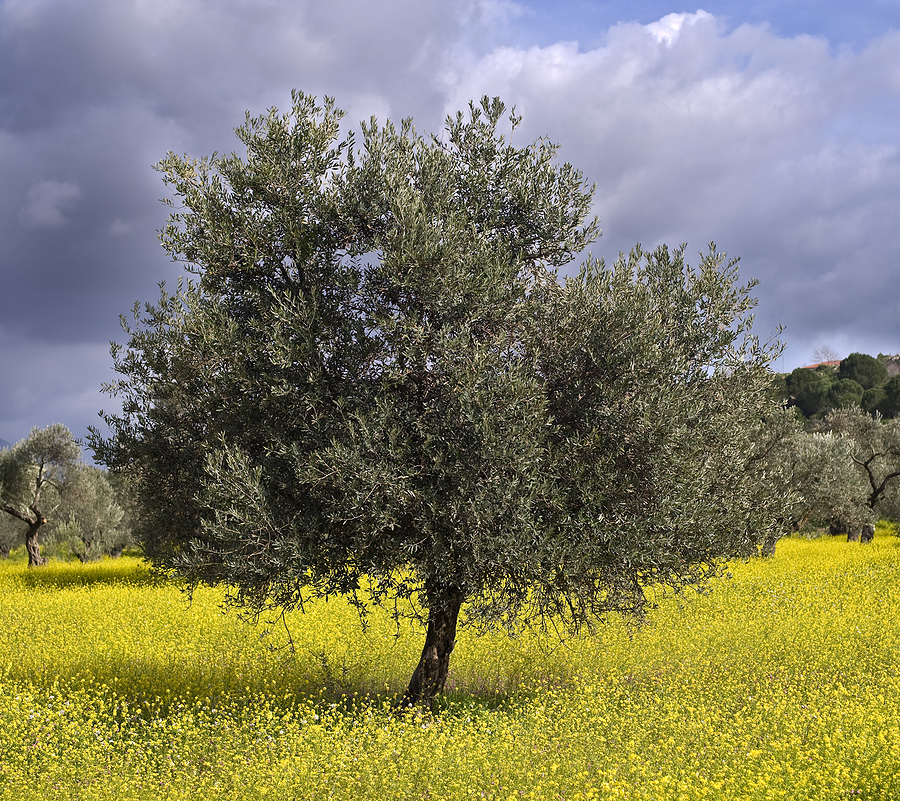
The olive is an evergreen plant that can grow as a shrub, hedge, or tree. Olive trees can grow as tall as 30 feet. Olives bear small pitted fruits that can be cured for table consumption or pressed for oil. Some olives are grown for ornamental use, often as shrubs or hedges–the olive’s narrow gray-green leaves offset the dark green of most gardens and the olive’s branching is noted for its billowing form.
Olives grow best where summers are long, hot, and humidity is low. They are easy to grow and care for.
There are dozens of olive varieties, the fruit varying slightly in size, shape, and flavor.
Olives are too bitter to eat raw. They are either cured for table serving or pressed for cooking oil.
The difference between green olives and black olives is simple. Black olives are harvested ripe. Green olives are harvested unripe. Both have a tangy, salty flavor after being cured.
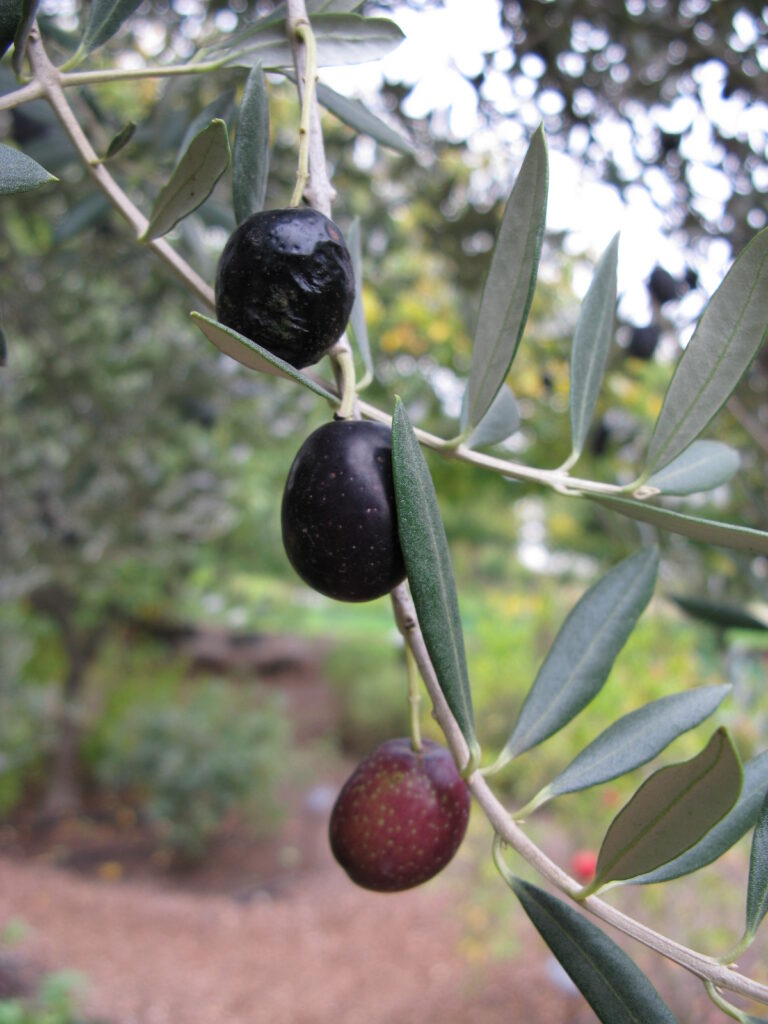
Here is your complete olive growing guide.
The best climate for growing olive trees
Olives grow best in full sun in regions with Mediterranean-type climates, long, hot, dry summers with some winter cold. Long summers are necessary to ripen olives, at least six months of frost-free weather is best. Olives, depending upon variety, require 200 to 500 hours of freezing weather to set sufficient blossoms for a full harvest. Olives are damaged by temperatures below 12°F; the fruit can not withstand temperatures below 28°F.
- Olives grow best where summers are long, hot, and humidity is low.
- USDA Zones 9 and 10 have optimal growing conditions for olives.
- Olives need some winter chill to produce flowers; mid-winter temperatures between 40° and 50°F are ideal; that said an olive tree can withstand freezing temperatures but will be killed at temperatures below 12°F.
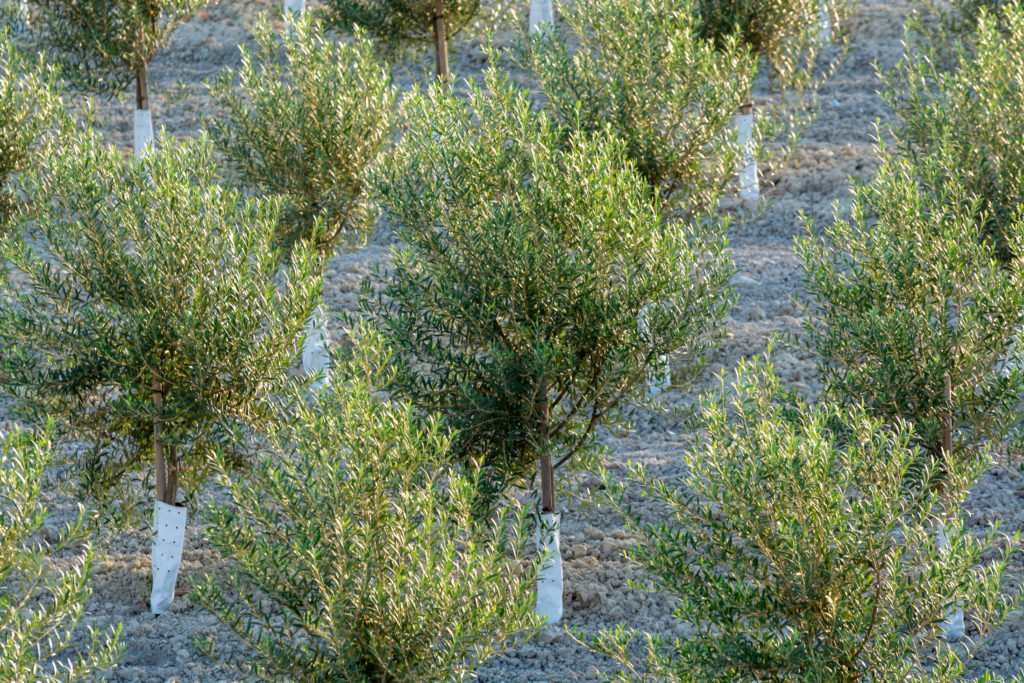
Where to plant an olive tree
Olives grow well in a wide range of soils, from sandy to loam to clay. The soil must be well drained. Olives are generally shallow-rooted plants.
- Grow olives in full sun.
- Plant olives in well-drained soil; sandy loam is best, but olives will adapt to most soils. Olives grow best when the soil pH is in the range of 5.5 to 8.5.
- Grow olives away from prevailing breezes or winds. Avoid planting olives in a low spot that collects cold air or frost.
- Avoid planting olives where fallen fruit will stain walkways or patios.
Choosing the right olive tree
Most olives are cultivated varieties, so seeds from these cultivars will revert to the original variety. That means hardwood cuttings are the preferred method of propagation. Use 2-year-old hardwood shoots taken in winter or semi-ripe cuttings taken in spring or summer. Cuttings usually require four years to begin fruiting.
- Some olives are best for oil, others for fruit—pickling, and preserving. Choose a variety suited to your needs.
- Contact the nearby Cooperative Extension Service for varieties that will grow well in your area.
Spacing olive trees
- Olives can grow 15 to 30 feet tall and wide; they can be trained and pruned to a smaller size.
- Space standard olives about 20 feet apart.
Olive tree pollination
Olives are self-fruitful. Climate and the tendency of olives–like other fruits–to bear more heavily every other year are the likely reasons for a small crop.
- Most olives are self-fruitful; however, they are more likely to flower and set fruit if pollinated by another olive growing nearby.
Planting an olive tree
- Plant olive trees in spring or fall; avoid planting olives during hot, dry summer weather.
- Prepare a planting site in full sun that is sheltered from a prevailing breeze or wind.
- Work well-rotted compost or manure into the soil.
- Dig a hole half again as deep and twice as wide as the tree’s roots. Add a cupful of all-purpose fertilizer to the bottom of the hole.
- Put a tree stake (or support wires for a fan) in place before planting. Drive the stake into the ground to the side of the hole to at least 2 feet deep.
- Set the plant in the hole so that the soil mark from the nursery pot on the stem is at the surface level or an inch or two deeper than the surrounding soil. (If you are planting a balled-and-burlapped tree, remove all twine and burlap from the planting hole.) Spread the roots out in all directions.
- Re-fill the hole with half native soil and half aged compost or commercial organic planting mix; firm in the soil so that there are no air pockets among the roots. Water in the soil and create a modest soil basin around the trunk to hold water at watering time.
- Secure the tree to the stake with tree ties.
- After planting, water each tree thoroughly and fertilize it with a high-phosphorus liquid starter fertilizer.
Container growing an olive tree
- Olives can be grown in containers.
- Choose a large pot or tub at least 18 inches wide and deep that is well-drained.
- Plant trees in a commercial organic potting mix.
- Keep the soil evenly moist but not wet.
- Feed olives growing in containers with an all-purpose fertilizer that is slightly higher in potassium.
- Repot the tree after two years into a container that is 24 inches wide and deep.
Olive tree care, feeding, and watering
- Olive trees need regular water until roots are well established. Mature trees will tolerate periods without much water, but they will benefit from regular water when buds and blooms are developing.
- Young olives will become established more quickly if they receive regular water. Mature olives generally are drought tolerant, but water during flowering and fruit formation will enhance the harvest.
- Olives are best fed with an annual application of garden compost or well-rotted manure around their trunks. Avoid nitrogen-rich amendments which boost green growth, not fruit growth.
- Fertilize olive trees annually with a few cups of nitrogen such as blood meal or cottonseed meal. Avoid over-fertilizing an olive tree or too many fruits will set.
Training olive trees
Olive trees are best trained to an open center. Here’s how:
- At planting, starting with a whip, cut off the central leader with an angled cut just above a bud at about 5 feet high. If the seedling has lateral branches, remove any laterals lower than 18 inches; prune back remaining laterals by half.
- During the first summer, cut back main laterals to about 8 inches from the start of this year’s growth; cut to buds that face outward; cut back new shoots or lateral to about 6 inches; leave the central leader untouched.
- The second spring after planting, cut back the central leader to about one-third of last year’s growth.
- In the following springs: cut back the central leader by two-thirds of the last year’s growth until it reaches the maximum desired height. Cut out any dead, damaged, or diseased wood. Remove old, unproductive growth to clear congestion at the center of the tree. Tip prune the central leader to about 1 inch of the previous year’s growth.
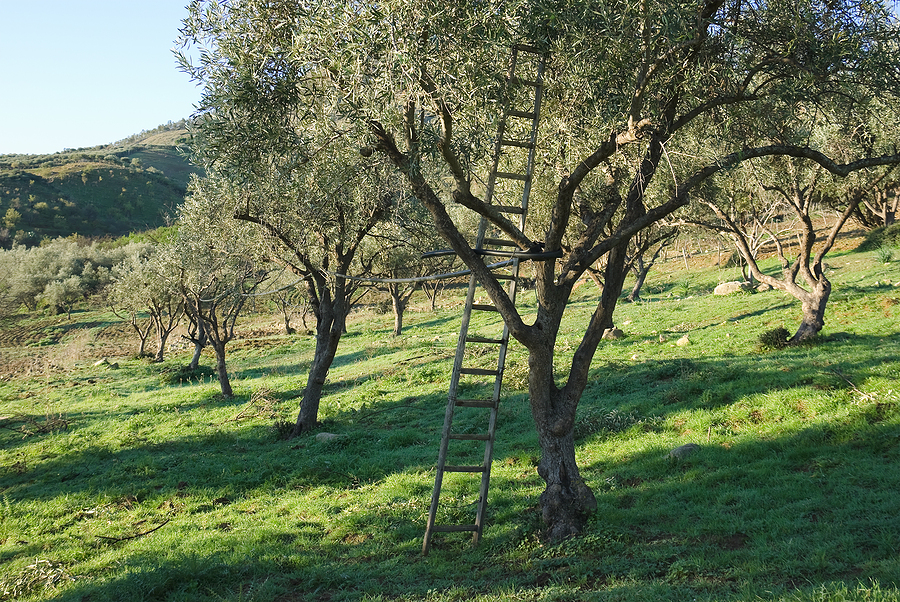
Pruning and thinning olive trees
Olives that are regularly pruned will perform the best. Prune out the sucker and lower branches to encourage a vase-shaped, open-centered tree. Three to five main scaffold branches work best. Olives produce fruit on 1-year-old branches so clip out stem tips to encourage the number of fruiting laterals. Keep olives pruned to a manageable harvest height.
- Prune established trees for shape and to keep them from growing too large; remove spindly branches.
- Prune out dead, damaged, or diseased wood; thin congested wood so that sunlight and air can get to the center of the tree.
- Thin fruit by removing excess fruit individually. Thin until there are about three or four fruits per foot of twig. The fruit size or remaining fruit will be increased by thinning. Thin fruits as soon as possible after the fruit set.
Olive tree pruning basics
Olive trees fruit along one-year-old wood usually at the periphery of the tree canopy. Prune each year to encourage wood that will fruit. Thin out broken, diseased, and unproductive wood. Head back drooping wood and prune out water sprouts. Olives are best trained on trunks 3 to 4 feet tall with 3 to 4 scaffold or main lateral branches trained or pruned to different directions beginning at about 4 feet from the ground. (Multi-trunked olives are often used ornamentally but can be kept to a manageable height for harvesting. Don’t allow multi-trunked trees to grow too dense in the center.)
Train and prune olives to an open center allowing sunlight to reach deep into the crown of the tree. Remove basal sprouts; pull them away don’t cut them to make sure they do not regrow. Rub off buds near the ground level that may become suckers. Olives that go unpruned will become densely twigged and crowded.
When to prune an olive tree
Prune olive trees in early spring before buds and flowers set. Olive trees can be thinned at any time of the year without damaging the tree. However, if you prune in late spring or summer after flowering, the harvest is likely to be decreased. You can prune in winter if the weather is frost-free and dry. Prune in dry weather to allow cuts to heal before frost or rain. Regularly pruned olives will require less pruning and thinning than trees that have been neglected. In regions with severe droughts, pruning in summer will reduce the number of leaves competing for water and may enhance the harvest.
Thinning olive trees
Olives fruit from the leaf axial along one-year-old wood or stems, not at the end of stems. Three to four fruits per foot are sufficient for a good crop. Thin away extra fruit to increase the size and oil content of the fruit on the tree. Thinning will also hasten the harvest and allow for a good harvest the next year. Olives are best thinned in late spring or early summer several weeks after the initial fruit set. Hand thinning is the most effective way to thin.
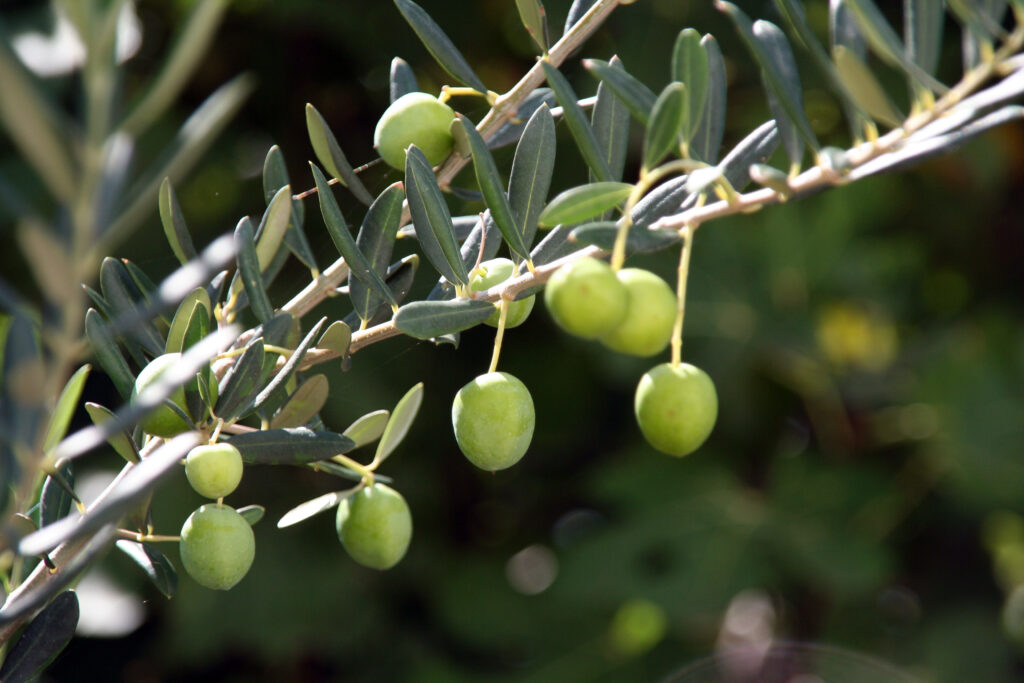
Training new olive trees
Train new trees to have a clear trunk 3 to 4 feet tall. Prune away side branches below where you want the main scaffold to branch; the main scaffold should begin at 4 to 5 feet from the ground. Select 3 or 4 well-spaced laterals or branches to form the main scaffold. Train these young branches in the desired direction away from each other.
When to begin training a new tree
There are two schools of thought on this. Some begin training new trees immediately, selecting a leader to become a trunk and then encouraging select laterals to form a scaffold. Others allow olive trees to grow for 3 or 4 years almost as a shrub before beginning to prune and train. This strategy allows the tree to gain strength and even begin to bear fruit before the main trunk and scaffold branches are selected.
Renovating mature olive trees
An overgrown and unattended olive should be pruned to regain the tree’s form and open its crown to sunlight. Prune to establish a clear trunk 3 to 4 feet tall. Prune out broken, dead, diseased, and unproductive wood first. Prune to establish a crown with 3 to 5 main branches. Once the main scaffold is established, thin out new shoots to open the tree to sunlight and continue to prune away suckers and water sprouts on a yearly schedule. An olive tree will recover from heavy pruning. Pruning will stimulate and encourage the growth of new fruiting wood.
Propagating olives
- Olives can be propagated by hardwood or softwood cuttings. Start softwood cuttings in the fall.
- Olives cultivars are often grafted onto a rootstock.
Olive tree pests, diseases, and problems
Olives have few pest and disease problems apart from birds that eat ripe fruit. Keeping trees healthy and pruned will reduce the risk of disease and insects.
- Olive knot disease is a bacterial disease that appears as swellings or galls; cut out the gall in summer to prevent the disease from spreading; remove two inches or more in diameter around the gall.
- Peacock spot fungal disease occurs in years with above-average rainfall; the infection appears on leaf blades and can lead to premature fruit drop. Apply copper fungicide in the fall before winter rains begin to control peacock spot.
- Scale is an insect with an elliptical shell that sucks sap from leaves and stems. Smother scale with horticultural oil or crush the insects.
- Verticillium wilt is a fungal disease that will cause leaves to discolor and curl; it can spread to other parts of the tree and can cause tree death in a few years. Remove diseased leaves and place them in the trash.
- Rake up and destroy any leaves of fruits that show signs of disease.
Fall and winter olive tree care
- Place a thick layer of composted manure around trees in the fall; winter rains will carry nutrients deep into the soil.
- Protect olives from freezing weather by covering plants with burlap or blankets.
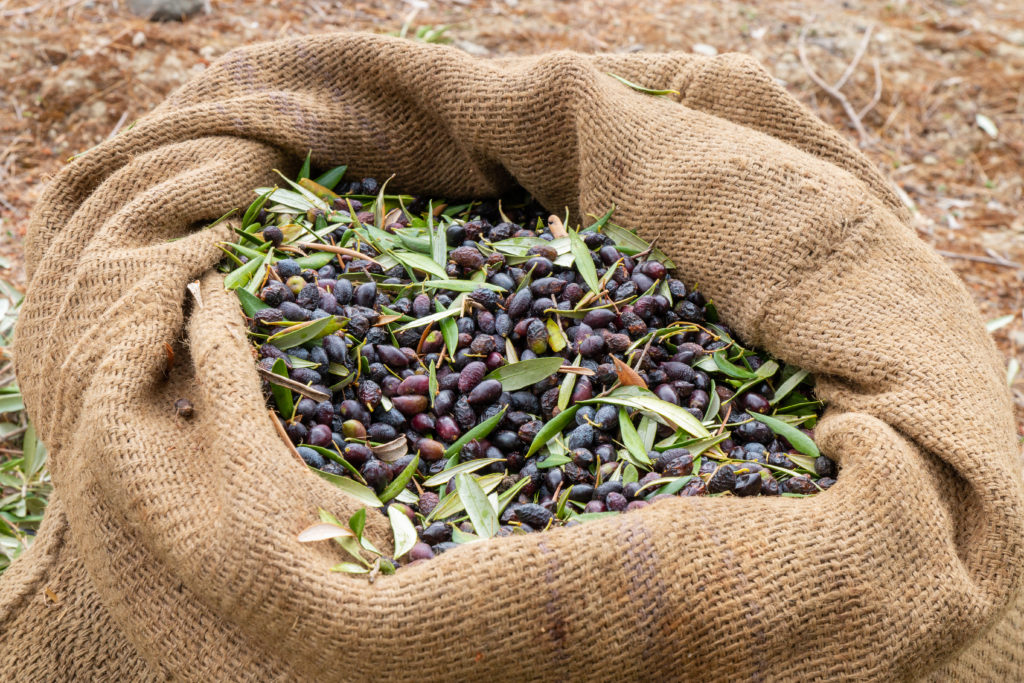
Harvesting and storing olives
Olives come to harvest in late autumn and winter about six months after flowering. Olives can be harvested green, unripe, or black and ripe. Olives can not be eaten directly from the tree; they contain a bitter alkaloid. Fresh olives can be crushed to make oil. Olives for table consumption must be cured before they can be eaten. Black olives can be cured by brining: ripe black olives are soaked in a salt solution for at least 3 weeks or in water that is changed daily for 7 to 10 days. The olives are then heated in boiling water, drained, and cooled; this process is repeated three times after which vinegar and salt (and other spices) are added to pickle the fruit. Green or near-ripe olives are cured by soaking in a series of lye solutions; they are then washed with clean water and transferred to a mild salt solution.
- Olives bear fruit four to five years after planting.
- Olive trees are alternate bearing: under normal conditions, they produce heavy crops one year and light one the next.
- Olives can be harvested either green (unripe) or black (ripe). For table fruit, harvest when the fruit is still green, just before the fruit turns the color of yellow straw, or when ripe and black. For oil, harvest when the fruit has turned black on the outside, but the flesh is still green/yellow.
- Pick by hand to avoid bruising when picking olives that will be picked for table use. Olives that will be used for oil can be knocked from the tree; hit the tree branches with a pole and then gather the fallen olives.
- Olives can be pickled green. Olives can be brined or canned for storage.
- All olives must be cured before they can be eaten. Table olives are cured with water, oil, brine, salt, or lye to dissipate their bitterness and to preserve them.
Olive varieties to grow
- ‘Ascolano’: large fruit with a small pit; good oil content but less than ‘Mission’ and ‘Manzanillo’; tender fruit; good for processing.
- ‘Manzanillo’: larger fruit than ‘Mission’; fruit ripens earlier; average oil content.
- ‘Mission’: medium-size fruit, blue-black when ripe; average oil content; greater cold resistance than other varieties
- ‘Sevillano’: the largest fruit with the least oil; the flesh has a woody texture.
Also of interest:
Related articles:
Planning the Home Fruit Garden
Garden Planning Books at Amazon:
- Vegetable Garden Almanac & Planner
- Kitchen Garden Grower’s Guide Vegetable Encyclopedia
- Vegetable Garden Grower’s Guide
- Tomato Grower’s Answer Book
More fruit-growing articles:
Learn how to plant, grow, prune, and harvest your favorite fruits. Click below for all you need to know.
- Apple
- Apricot
- Avocado
- Banana
- Blackberry
- Blueberry
- Cantaloupe
- Chayote
- Cherimoya
- Cherry
- Citrus
- Clementine
- Cranberry
- Currants
- Elderberry
- Feijoa
- Fig
- Gooseberry
- Grape
- Grapefruit
- Guava
- Kiwifruit
- Kumquat
- Lemon
- Lime
- Loquat
- Mandarin
- Mango
- Melon
- Mulberry
- Muskmelon
- Nectarine
- Olive
- Orange
- Papaya
- Passion Fruit
- Peach
- Pear
- Persimmon
- Pineapple
- Pineapple Guava
- Plantain
- Plum
- Pomegranate
- Pumpkin
- Quince
- Raspberry
- Strawberry
- Tangelo
- Tangerine
- Tangor
- Watermelon















